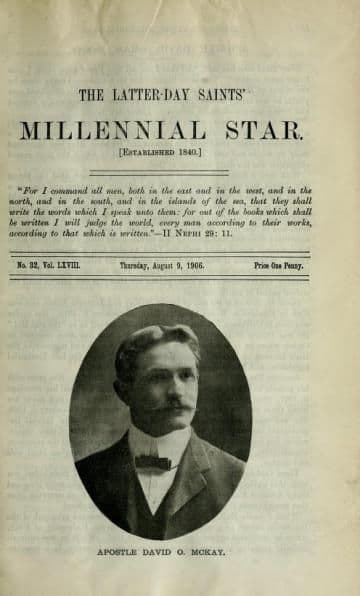Magazine
Some Traditions of the American Indians

Title
Some Traditions of the American Indians
Magazine
The Latter Day Saints' Millennial Star
Publication Type
Magazine Article
Year of Publication
1906
Authors
Bennett, William A. (Primary)
Pagination
510–511
Date Published
9 August 1906
Volume
68
Issue Number
32
Abstract
The author compares Apache Indian traditions to the Three Nephites of the Book of Mormon (3 Nephi 28). Apache Indians celebrate a rite that appears to recall the power and ministerial actions of the Three Nephites. Further, Apache Indians do not eat pork, a practice that may have been handed down to them from Lehi who carried the law of Moses to the American continent.
SOME TRADITIONS OF THE AMERICAN INDIANS.
BY ELDER WILLIAM A. BENNETT, OF THE BIRMINGHAM CONFERENCE.
In reading the account given of the three Nephite brethren in the 28th chapter of third Nephi, Book of Mormon, I am reminded of a circumstance that came under my observation sixteen or seventeen years ago in Arizona, U.S.A., while crossing the Apache Reservation. This incident, to my mind, proves the authenticity of the Book of Mormon.
In the spring of 1889 or 1890 I was engaged in the hauling of goods across the San Carlos part of the Apache Reservation. I, in company with a brother Charles Matthews, was camping at San Carlos, which was the post from which rations were distributed to the San Carlos and Tronto tribes of Apache Indians. Noticing that there were an unusual number of Indians encamped in and around San Carlos, I was led to ask the reason for it, as in those days there were many uprisings of the Apaches against the white man. I was told by the chief of the scouts that the Indians were gathered in for the purpose of holding their usual big spring dance, which was held with the object of driving the devil out of the soil, that they might raise good crops the following year; and I was informed that it would be worth my time if I stayed over for the day and attended the big pow-wow—which I accordingly did.
After securing our animals and eating our supper, we, with many others who had come for that purpose, went to the place selected by the Indians for the purpose of driving the devil from the soil. The first preparation made by them was to build a huge bonfire out of logs of wood. Near this fire sat a number of the old medicine men of the tribes, singing and beating time on a dried cowhide that was stretched across a pit which had been dug in the ground. After much singing and beating with sticks upon the dried skin, out popped the devil—or an Indian dressed so as to represent him—who ran off through the brush, that being the last seen of him.
Now, to the point I wish to make: after his Satanic majesty had disappeared, three men appeared, painted white, and adorned in all the splendors and beauties the Apache imagination could conceive. They represented three great medicine men. I was fortunate enough to be acquainted with a half-bred whom I had known for many years, who could talk both the English and Apache languages, and I asked him what those three men painted white represented. He told me that there was a tradition handed down by the Indians, that many, many snows ago there was a big chief amongst them who had a most lovely daughter, who was the pride of her father’s heart, as well as of all the tribe. She was taken very ill, and was nigh unto death, and the father sent throughout all the tribe, and had all the wise men and medicine men brought in, in order that they might cure his daughter. After applying all the arts and medicines, it was found that she grew worse, and when the father and the wise men had despaired of her life, three strange men came to his lodge and told them they were great medicine men, and that they could cure his daughter, which they did, after which they disappeared. No one knew where they came from nor where they went. Their appearance and dress were different from anything they had ever seen, and tradition has it that they were three medicine men sent by the Great Spirit, and that they returned back to Him. This tradition has, by these wild Indians, been perpetuated and handed down, by this annual spring dance.
I have thought of this incident many times since I have been on my mission here in England, and to my mind it is clear enough who those three strange men were.
Another thing I found among these Indians was that they will not eat the flesh of the hog, for as they say, the devil at one time entered into the hog, and has been there ever since, therefore it is unfit for food for man. I have many times given them a piece of bread and a bit of bacon when I knew they were hungry, and they would throw the bacon away and eat the dry bread. This before they became civilized. I think this is suggestive of one of the customs of the Israelites. This is one of the many traditions the American Indians have that has been handed down through the generations to the present time from Lehi and his sons, who left Jerusalem 400 B.C., and landed upon the coast of South America, and in time spread from there to the coasts of North America.
Subject Keywords
Bibliographic Citation
Terms of use
Items in the BMC Archive are made publicly available for non-commercial, private use. Inclusion within the BMC Archive does not imply endorsement. Items do not represent the official views of The Church of Jesus Christ of Latter-day Saints or of Book of Mormon Central.